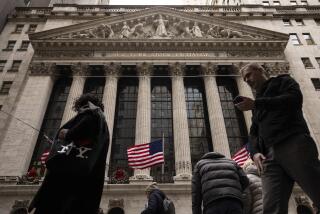Consumer Confidence at 10-Year Low : Economy: A monthly survey of 5,000 households blames the decline on the Gulf War. Meanwhile, the Commerce Dept. says the military buildup boosted orders for durable goods.
Uncertainty and concern over the Mideast conflict dragged consumer confidence in January to its lowest level in a decade, according to a survey released Tuesday.
But an unexpected finding was that consumer optimism was more pronounced in the first few days after the war started than in the two weeks before it, said the Conference Board, an economic research group that commissions the monthly survey.
In a separate report, the Commerce Department said orders for durable goods rose strongly in December, thanks to the military buildup caused by the gulf crisis and to demand for commercial aircraft. Excluding those two sectors, however, orders actually fell, and analysts say the economy remains mired in a recession.
“There is no sign of a recovery yet,” said Michael Penzer, vice president and senior economist at Bank of America.
In its monthly survey of 5,000 U.S. households, the Conference Board found that the gulf crisis played the biggest role in the decline in consumer confidence. The board’s Consumer Confidence Index fell to 54.0 in January from 61.2 in December. The index stood at 106.5 in January, 1990, before posting sharp declines in August, when Iraq invaded Kuwait, and again in October.
The index is based on a benchmark of 100 set in 1985.
“Most of this decline we think was due to the gulf crisis,” said Fabian Linden, executive director of the Conference Board’s Consumer Research Center. “There was no significant deterioration in the economy in January” to warrant such a decline.
In reviewing surveys taken before and after the Gulf War began on Jan. 17, Linden said that consumers were more confident after hostilities broke out. “In the first few days after the war began, there was a kind of euphoria,” said Linden. “We thought they were about to cry uncle. So people’s expectations were a lot more positive.”
An index of consumer expectations of the nation’s economic future stood at 51.6 for those surveyed before the war began. But the same index rose to 59.3 for people queried in the approximately 1 1/2 weeks after the war started.
“The war is going to have the most decisive short-term influence on the direction of consumer confidence,” said David Cross, a senior consultant at the Futures Group, an economic consulting firm in Washington. A long, bloody war would lower confidence levels, while its resolution would send confidence soaring, he said.
However, within a few months after hostilities end, Cross said he expects consumers will once again worry about the nation’s nagging economic problems. “The job market is not going to turn around because the war is over. The underlying fundamentals remain weak.”
The Conference Board survey also found that one-third of consumers described the business climate as “bad” and a similar proportion said jobs were “hard to get.” Looking ahead at the next six months, less than 20% of those surveyed expect their earnings to increase and only 5.6% plan to buy a car.
In a separate report released by the Commerce Department, durable goods orders rose 4.4% over November figures--way above the 2.5% gain expected by many economists. In November, orders had fallen a sharp 10.1%
Stronger demand for military equipment and commercial aircraft were behind most of the increase, economists said. After falling 26.9% in November, orders for defense-related goods soared 57% in December. Orders for aircraft and transportation goods were up 13.6% after falling by 25.2% in November.
Despite the sharp increases for defense and transportation goods, economists cautioned that the monthly statistics are highly volatile. It is not rare for the monthly defense figure, for example, to rise or fall by 20% to 30%. Changes in the transportation orders are also heavily influenced by the performance of one company: Boeing, the world’s largest maker of commercial jets.
By excluding the aircraft and defense orders, overall durable goods orders fell about 3.4%, said Bruce Steinberg, senior economist at Merrill Lynch. “That’s no sign of strength. That’s no sign of recovery,” he said. “I think the recession is certainly continuing.”
Durable goods orders for the entire year fell 1.6%, the Commerce Department said. That is the first annual decrease since 1982, when a recession reduced orders by 6.4%.
The Labor Department also reported that wages and salaries rose 4.9% in 1990 while inflation, as measured by the Consumer Price Index, rose 6.1% for the year.
Wages for white-collar workers rose 4.1% last year compared to 3.5% for blue collar employees, the department said. Executives and managers saw wages rise 5.3% during the year.
Durable Goods New orders Billions of dollars, seasonally adjusted Dec., ‘90: 121.6 Nov., ‘90: 116.4 Dec., ‘89: 131.7 Source: Commerce Department CONSUMER CONFIDENCE INDEX Based on a monthly survey of 5,000 U.S. households. 1985 equals 100 Jan., ‘91: 54.0 Dec., ‘90: 61.2 Jan., 90: 106.5
More to Read
Inside the business of entertainment
The Wide Shot brings you news, analysis and insights on everything from streaming wars to production — and what it all means for the future.
You may occasionally receive promotional content from the Los Angeles Times.










